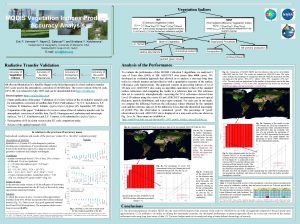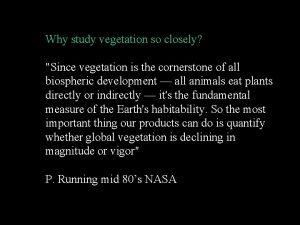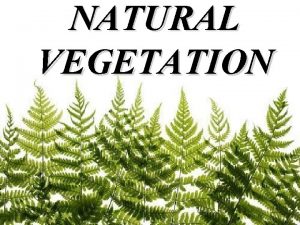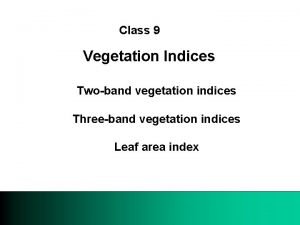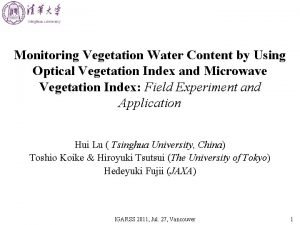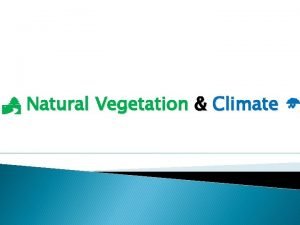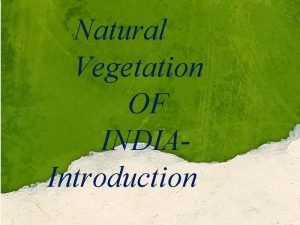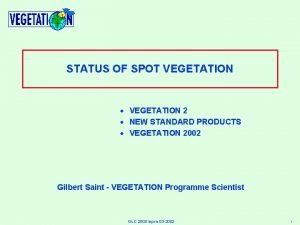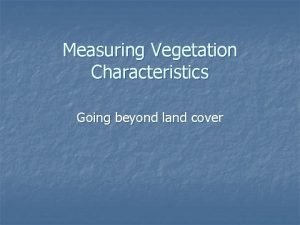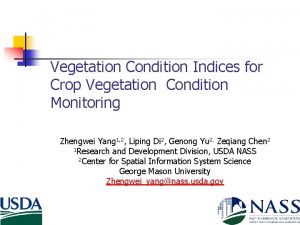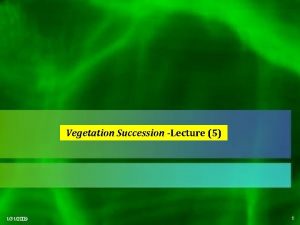Vegetation Vegetation is a general term for the

















- Slides: 17

Vegetation • Vegetation is a general term for the plant life of a region; it refers to the ground cover provided by plants. • It is broader than the term flora which refers to species composition.

Importance of Vegetation • First, vegetation regulates the flow of numerous biogeochemical cycles, include those of water, carbon, and nitrogen; it is also of great importance in local and global energy balances. Such cycles are important not only for global patterns of vegetation but also for those of climate. • Second, vegetation strongly affects soil characteristics, including soil volume, chemistry and texture, which feed back to affect various vegetation characteristics, including productivity and structure.

Importance of Vegetation • Third, vegetation serves as wildlife habitat ﻛﺒﻴﺌ ﺣﻴﺎﺓ ﺑﺮ and the energy source for the vast array ﻟﻠ ﺍﻟﻮﺍﺳ of animal species on the planet. Perhaps most importantly, global vegetation (including algal communities) has been the primary source of oxygen in the atmosphere, enabling the aerobic metabolism systems to evolve ﺗﺘﻄﻮﺭ and persist ﺗﺴﺘﻤﺮ.

Vegetation Analysis and sampling • Minimal sample area • Minimal area of a community is defined as ״ the smallest area on which the species composition of the community in question is adequately represented ״

Vegetation Analysis and sampling • Many questions come to mind to study the importance of a particular species of plant in a community: • 1 - How widely distributed this species? • 2 - How many plants of this species are present in the community? • 3 - How much of the total available space ? • 4 - Does this species occupy?

Vegetation Analysis and sampling • If you can answer these questions, you can conduct some interesting and important studies. • For examples, • 1 - you can compare the vegetation in one region with that in another. • 2 - you can study seasonal changes in vegetation within a given area. • 3 - you can determine the relationships between plant populations and abiotic factors. • 4 - you can investigate ecological plant succession.

Vegetation Analysis and sampling The Quadrat Method • The quadrat method is one of the most widely used means of showing quantitative information about the compositions and structure of plant communities. • the method appears quite simple. • You examine the study area at several sites by using quadrats.

Quadrat • The word “quadrat” explains a square plot is used in this method of vegetation analysis. However, circular and rectangular plots are often used. • The choice of shape depends on the nature of the vegetation being investigated.

Shape of Quadrat • 1 - Circular plots • give more valid results with low vegetation than will a similar number of square plots of the same area. • Circular plots can be used effectively on areas of low vegetation.

Shape of Quadrat • 2 - Square and rectangular plots can be used in vegetation of any height. • Rectangular plots usually give more accurate results than an equal number of square plots of the same area. ……. why • Because rectangular plots sample have a greater length of the vegetation and are more accurate to detect variations in it.

Size of Quadrat • Both the height and the density of the plants in the study area should be considered when you are deciding what size quadrat to use. • The quadrat must be : • 1 - large enough to contain a significant number of plants. • 2 - small enough to permit you to identify, count and measure the plants in a suitable length of time.

Size of Quadrat • Mosses and lichens: 0. 1 square meter • Herbs (including grasses) and tree seedlings: 1 square meter • Shrubs : 10 – 20 square meters up to 10 feet • Trees 100 square meters

Kinds of Quadrats • a). List quadrat. In this type of quadrat the plants within the frame are identified and listed by name. • No count of numbers is made. • If sufficient list quadrats are used over the study area, you can calculate the frequency of occurrence of each species, that is, the number of quadrats in which each species occurs.

Kinds of Quadrats • b). The permanent quadrat. This refers to the limiting area of the quadrate for a long time without changing in location of quadrate when there is a need to visit these sample areas for several times over a long period. • In these cases 1 - It is possible to review the changes in the types of plants, • 2 - The number of individuals belonging to each kind, • 3 - Relative distribution and changes in the cover of different species.

Kinds of Quadrats • c). Cover (Basal- area) quadrat. In ecological studies it is desirable to know what percentage of the land surface in the study area is “covered’ by a certain species. • A cover quadrat determines : • The total basal cover is different according to the age of stand; young or old. • The total basal area increases by developing the community towards the climax.

Kinds of Quadrats • d). Chart quadrat. A chart quadrat is a map, showing the positions of the various plants. • The chart quadrat is useful if you plan to conduct studies of the same area over a long period of time. • Changes in vegetation patterns with time are best followed with the chart quadrat.

Kinds of Quadrats • E). Denuded quadrate. This quadrate is used for determining the rate of invasion and establishment of vegetation on badly depleted areas. ( )ﺍﻟﺒﻮﺭ • The quadrate may be placed in area entirely or nearly denuded by grazing animals, burning, flooding or any kind of disturbances. • When a portion of soil surface is removed or disturbed the quadrate become partially denuded.
 Kontinuitetshantering i praktiken
Kontinuitetshantering i praktiken Typiska novell drag
Typiska novell drag Nationell inriktning för artificiell intelligens
Nationell inriktning för artificiell intelligens Vad står k.r.å.k.a.n för
Vad står k.r.å.k.a.n för Varför kallas perioden 1918-1939 för mellankrigstiden?
Varför kallas perioden 1918-1939 för mellankrigstiden? En lathund för arbete med kontinuitetshantering
En lathund för arbete med kontinuitetshantering Adressändring ideell förening
Adressändring ideell förening Tidbok yrkesförare
Tidbok yrkesförare Sura för anatom
Sura för anatom Förklara densitet för barn
Förklara densitet för barn Datorkunskap för nybörjare
Datorkunskap för nybörjare Stig kerman
Stig kerman Att skriva debattartikel
Att skriva debattartikel Autokratiskt ledarskap
Autokratiskt ledarskap Nyckelkompetenser för livslångt lärande
Nyckelkompetenser för livslångt lärande Påbyggnader för flakfordon
Påbyggnader för flakfordon Kraft per area
Kraft per area Publik sektor
Publik sektor



















